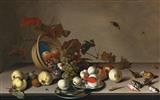Balthasar van der Ast
(Middelburg 1593/94–1657 Delft)
A fruit still life with a wicker basket, shells and a butterfly,
signed (on the ledge): B. van der. Ast,
oil on panel, 64 x 102.3 cm, framed
Provenance:
sale, Frederick Muller, Amsterdam, 26 June 1923, no. 2;
purchased by the grandparents of the present owner, circa 1932/33, Hilversum, The Netherlands
Literature:
L. J. Bol, The Bosschaert Dynasty, Leigh-on-Sea, 1960, pp. 85/86, no. 114
Balthasar van der Ast was one of the leading Netherlandish still life painters of the seventeenth century. He was the brother of the lesser-known painter Hans van der Ast and both the brother-in-law and pupil of the still life painter Ambrosius Bosschaert I. Van der Ast left behind a large oeuvre. L. J. Bol compiled a list of 126 paintings by the artist’s hand as early as 1960. Most of them are signed, but as they are rarely dated it is very difficult to order his corpus chronologically. His production comprises bouquets of flowers, solitary flowers on a table, still lifes of fruit featuring faience or pewter plates and baskets, still lifes of sea shells, and banquet still lifes.
E. Gemar-Koeltzsch writes about the painter (in: Holländische Stilllebenmaler im 17. Jahrhundert, vol. 2, Lingen 1995, p. 44): ‘Especially in the early still lifes of Balthasar van der Ast, the influence of his teacher and brother-in-law Ambrosius Bosschaert the Elder is evident. Both the way in which his bouquets are arranged and the choice of blossoms follow the type of flower piece developed by Bosschaert. However, some of Balthasar van der Ast’s paintings also reveal how the artist made reference to Roelant Savery, such as in the addition and appearance of a number of small animals’.
‘Yet Balthasar van der Ast arrived at his own style at an early phase in his career, which identified him as a progressive painter of his time […]. A typical feature of Balthasar van der Ast’s art is a chiaroscuro dominated by greys, distinctly differentiating between light and shadow while displaying soft transitions all the same. His compositions sound the possibilities of spatial depth and simultaneously emphasise the two-dimensionality of the picture plane. This is achieved by the way in which his objects in the background always extend to the upper margin of a composition or, displayed as silhouettes, prevent the viewer’s gaze from looking into a presumed spatial depth.’
The present work seems to bear all the hallmarks of the artist’s own style as outlined by the art historian Gemar-Koeltzsch. This mature style by Balthasar van Ast turned him into one of the most successful artists of his generation.
View it on
Sale price
Estimate
Time, Location
Auction House
(Middelburg 1593/94–1657 Delft)
A fruit still life with a wicker basket, shells and a butterfly,
signed (on the ledge): B. van der. Ast,
oil on panel, 64 x 102.3 cm, framed
Provenance:
sale, Frederick Muller, Amsterdam, 26 June 1923, no. 2;
purchased by the grandparents of the present owner, circa 1932/33, Hilversum, The Netherlands
Literature:
L. J. Bol, The Bosschaert Dynasty, Leigh-on-Sea, 1960, pp. 85/86, no. 114
Balthasar van der Ast was one of the leading Netherlandish still life painters of the seventeenth century. He was the brother of the lesser-known painter Hans van der Ast and both the brother-in-law and pupil of the still life painter Ambrosius Bosschaert I. Van der Ast left behind a large oeuvre. L. J. Bol compiled a list of 126 paintings by the artist’s hand as early as 1960. Most of them are signed, but as they are rarely dated it is very difficult to order his corpus chronologically. His production comprises bouquets of flowers, solitary flowers on a table, still lifes of fruit featuring faience or pewter plates and baskets, still lifes of sea shells, and banquet still lifes.
E. Gemar-Koeltzsch writes about the painter (in: Holländische Stilllebenmaler im 17. Jahrhundert, vol. 2, Lingen 1995, p. 44): ‘Especially in the early still lifes of Balthasar van der Ast, the influence of his teacher and brother-in-law Ambrosius Bosschaert the Elder is evident. Both the way in which his bouquets are arranged and the choice of blossoms follow the type of flower piece developed by Bosschaert. However, some of Balthasar van der Ast’s paintings also reveal how the artist made reference to Roelant Savery, such as in the addition and appearance of a number of small animals’.
‘Yet Balthasar van der Ast arrived at his own style at an early phase in his career, which identified him as a progressive painter of his time […]. A typical feature of Balthasar van der Ast’s art is a chiaroscuro dominated by greys, distinctly differentiating between light and shadow while displaying soft transitions all the same. His compositions sound the possibilities of spatial depth and simultaneously emphasise the two-dimensionality of the picture plane. This is achieved by the way in which his objects in the background always extend to the upper margin of a composition or, displayed as silhouettes, prevent the viewer’s gaze from looking into a presumed spatial depth.’
The present work seems to bear all the hallmarks of the artist’s own style as outlined by the art historian Gemar-Koeltzsch. This mature style by Balthasar van Ast turned him into one of the most successful artists of his generation.



